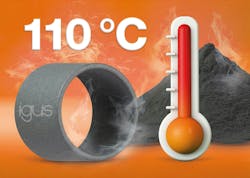Advancing High-Temperature 3D Printing with igus iglide i230
Igus has launched iglide i230 3D printing material specifically designed for high-temperature applications. The new powder material, which is suitable for selective laser sintering (SLS), can endure temperatures up to 110°C, offering expanded possibilities for SLS-printed polymer components.
Traditional SLS printing materials like PA (nylon) 12 are typically limited to applications under 80°C due to softening under higher temperatures, such as in automotive engines. According to a company release, the iglide i230 material can withstand temperatures up to 110°C long term and momentarily tolerate 170°C without deformation, as demonstrated by tests conforming to DIN EN ISO 75 HDT-A and HDT-B standards.
READ MORE: Hannover Messe 2024 Preview: Automation, Digitalization and Electrification
Paul Gomer, 3D printing material developer at igus, said in the release that components made with the material show increased mechanical strength compared with PA 12, allowing for the same component strength while reducing weight and space in applications.
Key features of the new material include:
- PTFE-free
- Capable of withstanding pressures of 94 MPa during bending tests
- Provide protection against electrostatic discharge
- Integrates solid lubricants, eliminating the need for relubrication
- Ensures low-friction, dry operation.
READ MORE: Automate 2024 Preview: Robotics, Vision, Artificial Intelligence, Motion Control
The iglide i230 materials is suitable for applications where PFAS-free materials with high mechanical strength and ESD properties up to 110°C are required. It is ideal for applications that demand better ear resistance and flexural strength compared with other iglide SLS materials.
Interested parties can become beta testers by requesting a sample at the igus website. The material is not recommended for applications that need higher wear resistance below 80°C, ESD properties up to 80°C, worm wheel applications, food-safe materials, high-elasticity components or temperatures that exceed 110°C long term.
About the Author
Sharon Spielman
Technical Editor, Machine Design
As Machine Design’s technical editor, Sharon Spielman produces content for the brand’s focus audience—design and multidisciplinary engineers. Her beat includes 3D printing/CAD; mechanical and motion systems, with an emphasis on pneumatics and linear motion; automation; robotics; and CNC machining.
Spielman has more than three decades of experience as a writer and editor for a range of B2B brands, including those that cover machine design; electrical design and manufacturing; interconnection technology; food and beverage manufacturing; process heating and cooling; finishing; and package converting.
Email: [email protected]
LinkedIn: @sharonspielman
Facebook: Machine Design
YouTube: @MachineDesign-EBM

